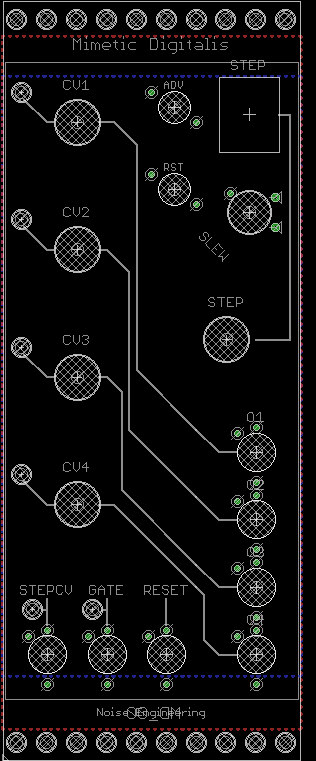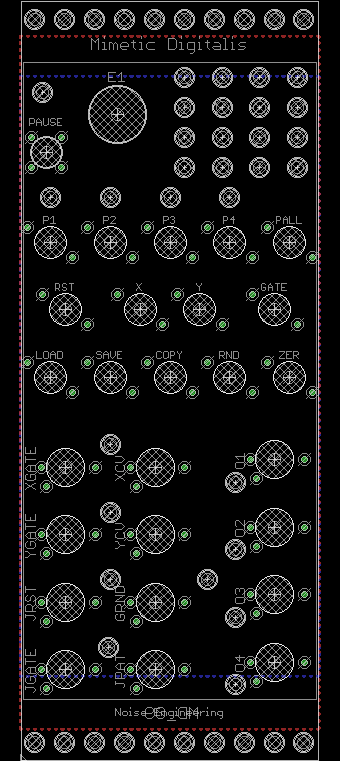Mimetic Digitalis: An Origin Story
In the latest NE Blog, we’ll talk more deeply about the new Mimetic Digitalis, the 16-step CV sequencer shipping May 1. A lot of the experience for what the MD became is from using it in live sets recorded during the summer of 2017. Many of these are available on our YouTube channel and if you look closely, you can see an evolution of MD hardware, features and techniques throughout these recordings. Here, we’ll talk a bit more about the history of the module and the thinking behind the design as well as some of the deeper functions this beast can do. We'll be adding MD content to our YouTube channel and social media over the next few weeks, so subscribe to those for updates!
The idea of the MD started as a 4-channel CV sequencer, so the very core of it has not changed, and it has remained constant at 10 hp...but pretty much everything else has diverged radically from where it started.

We built the first prototype out and pretty quickly realized that the 4-channel CV was great but everything else had to be changed. So we went back to the drawing board. At any given time, we usually have a number of prototypes in play, some of which never come to market. Around this time, we had one that we were testing that included XY sequencing. When we got the first hardware on it, we liked the features, but it was huge and the format just wasn’t quite right. A bit of restructuring and we realized that we could combine that prototype with the MD. This change also allowed us to move from one encoder per channel to a single encoder. Fewer encoders meant more room for other goodies!
By revision 9 (not all of the versions in between were actually built), we had something a lot closer to what we have today:

At that point, we had a lot of design decisions to make. For example, all the CV inputs on our modules are on the bottoms. If the CV outs on the MD were also on the bottom, were we setting users up for cable catastrophes? A bit of experimenting showed that putting the outputs up top made far more sense. We toyed with the idea of reversibility, but then the steps had to be reversible too. This made less sense if we wanted to have a color cue at the start of each line and posed a number of other issues for the functionality. We went back and forth like this for a while, trying to decide which was better.
A number of tweaks across the revisions were user-interface oriented. The encoder for tuning steps was originally on the left, but we were always using our right hand to tune it...which meant that we were blocking view of the module. We moved it to the right side of the module to alleviate this (sorry, lefties!). The final hardware moved things around a little more for ease of build and for ease of use.

From the start, we had two main guiding principles: the first was that there should be no menu diving: it should be easy to use right out of the box with no memorization needed to make it work. The other thing we knew was that we wanted it to be useful for live settings. What was the feature set we needed for that?
One of the first features added once we started road testing was the ability to record the motion of the encoder as the sequencer advances. This is very useful for performing as one can just push and turn the knob and produce a repeatable stepped sweep.
Another feature that was originally done to reduce the panel size was to use select buttons for part editing. This allows the simultaneous editing of parts which is another performance feature. It becomes trivial to do things like clear all parts. Zero and shred were also inspired from testing the unit in a live setting. Zero is a pretty obvious but extremely useful feature. Both of these combine in synergistic ways to provide a tremendous amount of live playability.

One of the last features we added was Undo. Undo is a really quick and fun way to bring the sequence back to where it was before you started playing around. You can also use it to return to themes/motifs/choruses in your set. It’s a lot of fun to use.
Near the end of development, once we’d logged a few hours on what we were pretty sure was close to final hardware, we made the hard decision to add some particularly useful key combinations. We realized that playability was increased with a few simple combos despite having originally tried to avoid them.
Then, about a week before release, our friend Shawn came to us with an idea that was so good that we couldn’t pass it up. You know how sometimes you’re noodling around on your sequencer and then BAM! There it is! The sequence you want! Wouldn’t it be great if there were a way to line up that sequence so it starts at the first beat (or some other arbitrary spot)?
Now there is.
Press the Origin button and turn the encoder to align the channels you select to whichever step you want.
Thanks, Shawn.
We are pretty happy with the MD and the punch it packs in 10HP. We hope you are too.
Stay tuned to the Noise Engineering blog for tips and tricks for modular users and guest posts from users who have nifty ways of using modular. And if you have questions you'd like to see answered here, please drop us a line.





